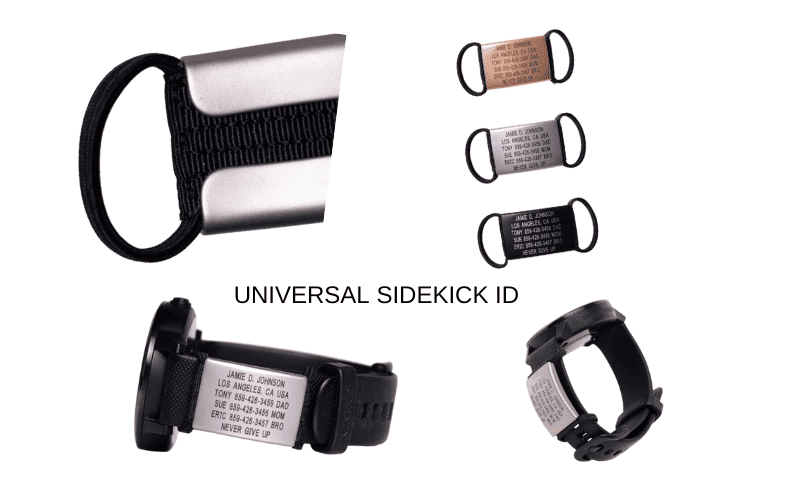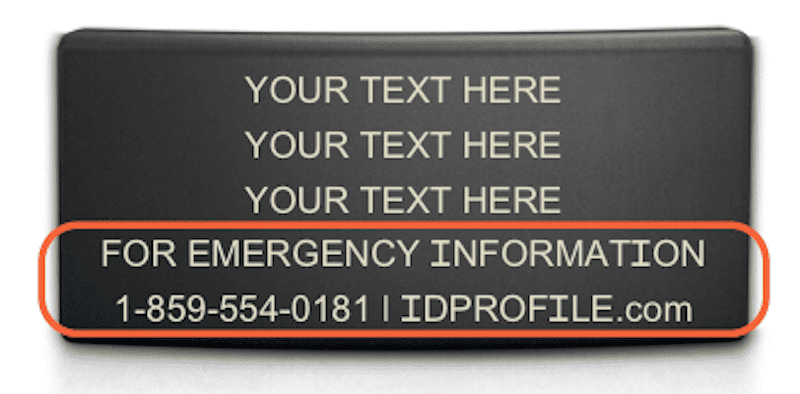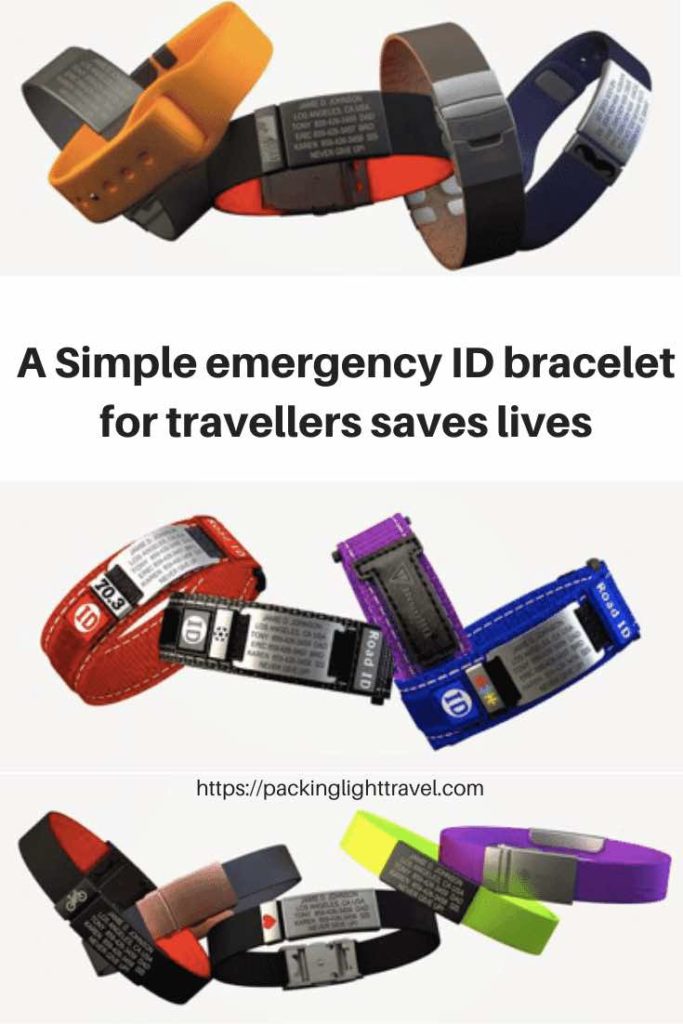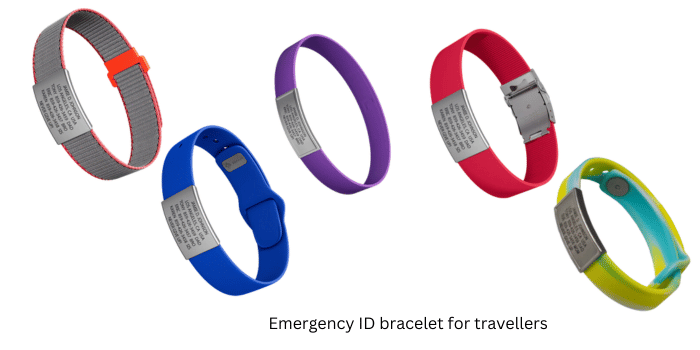Updated August 11, 2024
When travelling, what do you take with you to help establish your identity in cases of emergency? But, perhaps more importantly, what do you carry in the event you’re not in a position to speak for yourself? If an unexpected emergency strikes, an emergency ID bracelet for travellers might be the most important item on your packing list.
Many travellers carry emergency contact numbers and identification in a day bag, wallet, and phone. But these may not be noticed, or readily accessible to others when they’re most needed. The wearable ID company RoadID has a solution. It produces bracelets, shoe tags, bar pendants, military-type tags, ankle bracelets, and other forms of identification for runners, cyclists, and other athletes.
A simple emergency ID bracelet is useful not only for athletes, but in a variety of travel situations, especially when travelling solo.
Emergency ID bracelet for travellers
The results of a survey of emergency medical professionals by American Medical ID revealed that:
- more than 95 percent of respondents look for a medical ID during emergencies;
- more than 75 percent look for a medical ID immediately upon assessing a patient;
- 95 percent look at the patient’s wrist to find a medical ID, and 68 percent look for an ID on the patient’s neck.
RoadID offers a selection of wristbands. The Stretch is a silicone band that slides over the hand with no clasps or buckles as part of the design. The straps on the more stylish and dressier Elite are also silicone, but with a stainless steel clasp. The Sport Pin-Tuck has a pin-tuck closure. The Nylon Loop has a secure hook-and-loop closure. The Kidsafe has a unique, adjustable closure to fit wrists of all sizes.

For my first purchase in 2013, I decided on an Elite bracelet with a black silicone band and watch-style buckle. Many colours are available but I chose black because it blends nicely with any cycling or non-cycling outfit. I didn’t want to be tempted into removing the bracelet at any time between leaving and returning home.
When I needed an updated information plate in 2017, I noticed the Elite was available in two sizes (the original 19 mm / ¾ in and a narrower 13 mm / ½ in). The smaller became my second purchase and I couldn’t be more pleased.
The Universal Sidekick ID is built for watches and fitness devices. In this era of wearable technology, it’s a handy given the reality of limited wrist real estate.

1. Choosing ID information
Each bracelet comes with a removable laser-engraved stainless steel information plate available in slate (grey), graphite (black), and rose gold. Removability is a handy feature when updating information. It’s a plus for the pocket and the environment because just the plate needs to be replaced. The plate for the wider Elite accommodates six lines of customizable personal information; the narrower Elite has space for five.
Space is at a premium on the information plates. It can be a challenge figuring out the most important information to include. The process is simplified using Road ID’s helpful suggestions in its online ID builder. For my first purchase, I stuck with the basics. I included my name, city, province and country of residence, a couple of ICE (In Case of Emergency) contacts, year of birth, information on known allergies and the fact I’m an organ donor.
Personalization can be enhanced by adding a badge. For those with medical issues, RoadID offers medical alert and diabetic type 1 options.
2. Keep information updated
After a year of use, I decided to replace the original plate with an updated version more consistent with my needs while travelling.
After listening to Indie Travel Podcast #148: Travel Safety and Security Advice, I decided to update my personal information with my passport number and country of citizenship. The podcast described difficulties in confirming the identity of a person involved in a motor vehicle accident after his belongings had been stolen at the scene. This led to delays in transporting him to another country to obtain better quality medical attention.
In addition, I decided to add the name of my emergency medical insurance administrator and their toll-free number. This was prompted by a report of a Toronto woman who was the victim of a shark attack in Mexico. She suffered delays in a hospital emergency room because of a question as to whether or not she had insurance coverage.
I figured both of these details were more important at the emergency response and early treatment stages than the fact I’m an organ donor. I was able to move my year of birth and “NKA” (no known allergies) to create space for the additional information. As the number of my insurance policy changes from year to year, it’s not included. However, with my name and year of birth, the insurance company can locate my policy and confirm my coverage.

3. Original and interactive versions
RoadID offers both ‘original’ and ‘interactive’ ways to record personal details. The original format is static – all personal details are engraved on the information plate.
The interactive format displays a limited amount of personal information. Information such as medical history, allergies, emergency medical insurance, and more (created by you) is stored online. The information plate includes your serial and PIN numbers, and RoadID’s toll-free number and website address for access to your online Interactive Road ID.
The interactive plan incurs an annual fee of USD 19.99.

A recurring fee isn’t for me, and besides, I suspect that first responders don’t have the time to follow these extra steps in critical situations. I can see where it could be useful at the treatment stage, especially for someone with a complicated medical history, or where information changes on a regular basis.
4. Wear it for the entire trip
Because the bracelet copes well with both fresh and salt water (and the minerals in thermal springs), there’s no need to remove it at any time during your travels. Unfortunately, this is a shortcoming of combining a RoadID plate with electronic wearables. They aren’t waterproof so a bracelet needs to be removed while showering, swimming, or participating in activities around water.
The bracelet is a great conversation starter. People often ask about it, so it’s an ideal opportunity to talk about planning for emergencies while travelling, and the joys of combining cycling and travel.
4. Why I like the Elite
I ordered a black band and the black information plate and clasp.
- It’s slim and stylish, and less ‘clunky looking’ than the wider Elite. As such, it transitions well from an active day to dressier wear.
- With the band, information plate, and clasp in black, it doesn’t shout ‘ID bracelet.’ It’s less obtrusive.
- It’s light and comfortable, and never in the way.
- As soon I would return home from my travels, I’d return my wider Elite to its tin, ready for the next adventure. However, the narrower Elite remains on my wrist at all times. It’s so comfortable, and so handy for times when I’m out cycling, or otherwise without other forms of identification, that I see no reason to remove it. It hasn’t left my wrist in five years, except to clean periodically.
- The clasp is amazing. It’s comfortable on the wrist and has never failed by releasing unintentionally. Not once.
Conclusion
Wearing ID bands and tags is an effortless way to have personal identification and medical information readily available in case of emergencies. But, are they a gimmick or a necessity? RoadID claims that the company has impacted over five million lives since 1999. Read the host of RoadID testimonials from athletes, family members, and first responders and decide for yourself.
Might you be interested in these related posts on emergency preparedness?
- How to make a traveller’s emergency contact card in 5 easy steps
- 9 Tested reasons to carry laminated copies of your passport
- 10 Essentials of packing for a travel medical emergency
- 16 Tips on how to assemble a perfect travel first-aid kit
- Emergency preparedness toolkit for travel: 25 proven ideas
If you found this post helpful, please share it by selecting one or more social media buttons. What do you carry to establish your identity in an emergency situation? Please add your thoughts in the comments. Thank you.
Care to pin it for later?







Thanks, Anne. As always a very useful blog. Detailed, thoughtful, convincing helpful, well written, concise, clear.
Nice post.
Travelers must use medical alert devices if they are suffering from disease like diabetes. My husband is diabetic and his job requires him to travel a lot; so he has worn medical bracelet on his wrist.
These are really cool. Great idea for travelers.
Hannah recently posted…#DadBooks Was Trending on Twitter and I Got Distracted
Your blog is wonderful, this idea is great for use blaceletes is very useful when traveling
Also look at MedicAlert, especially the subscription service. I have worn their silver bracelet for many years of travel. I believe American emergency responders are supposed to be trained for look for it. http://www.medicalert.org/
If you have an iPhone running iOS 9.0 or later, you can use their App the emergency functionality. It isn’t as good, but… https://www.tekrevue.com/tip/iphone-medical-id/
MedicAlert bands are designed to the save the lives of the people who need immediate treatment, but cannot speak about the cause they are suffering from. My grandmother is a cancer patient ad she always wore on their hand.
Sandra Larsen recently posted…Stylish Medical Alert Rubber Bracelets – A Perfect Identification Accessory
I love my emergency ID bracelet, and the engraving on it just looks so nice and clean. It is super durable. Thanks for sharing!
The emergency bracelets can be very useful as if any anyone passes out others can understand that they have diabetes.
Thanks a lot for the info.
Follow
Diabetic Bracelets for Men and Women Reviews
I think it is key to keep clear ID with emergency phone numbers installed. I would love to see Road ID one day be able to create a GPS tracking system so the wifey can follow me while I ride.
According to my point of view, This post is very helpful for travelers. The emergency bracelets can be very useful for all. Thank you so much. In the same, This is amazingly durable.
Delhi to Jaipur One Way Taxi
Hi Anne,
Thanks for your great informative writing.
I enjoy your post. This is a very detailed and useful sight! Thanks again for sharing!
Runner Jimu Mantasha recently posted…Top 10 Best Stability Running Shoes for Beginners and Expert Runners
Hi Anne,
Thanks for the amazing article. It definitely covers all the points.